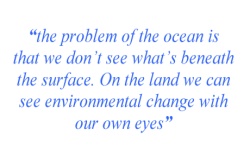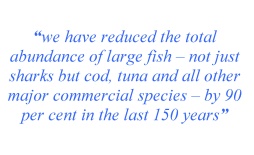
Research Highlight #1
Where are the big fish?
By Poul Holm
Ireland is an island in the Atlantic, and our waters were once brimming with sea life. But huge changes have taken place, and there are much fewer fish today than only one or two generations ago.

The problem of the ocean is that we don't see what's beneath the surface. On the land we can see environmental change with our own eyes. That is why fishermen's own records deserve attention. Historical studies of several hundred years of fishermen's logs, business records, monastic archives and other evidence of the industry itself reveal the scale of change in what we have extracted from the ocean. The story boils down to one single figure: we have reduced the total abundance of large fish – not just sharks but cod, tuna and all other major commercial species – by 90 per cent in the last 150 years. And the big fish are much smaller today than they used to be.
Skippers' logbooks are a clear indication of the scale of change. In 1874 the British fisheries observer Edmund Holdsworth noted the first indication of change: ‘It has been observed that when any newly-discovered cod-bank is first worked some fish of remarkable size are pretty sure to be caught. … But monster-cod five or six feet in length [152-183 cm], as were at first frequently reported, are now very seldom met with.'
There is a strong correlation between length and weight of fish. A ‘monster-cod' of five- feet would have weighed 37 kg and cod of six feet would have the astonishing weight of 64 kg. Such cod sizes are enormous in comparison to the cod caught in the North Sea today. The average for North Sea cod catches in the last fifty years was between 1.1 and 2.5 kg. The average North Sea cod is caught at the age of 2.8 years - it will only spawn at the age of three years - and is about 50cm long.
Similar declines are known for the ling – previously a popular fish for general consumption but now caught so rarely that is considered commercially extinct. The normal length for ling today is an average of 80 cm, down from a normal distribution in catches recorded in 1843-45 of between 90 and 125 cm. That is a 30% reduction in length, which converts to much more in kg: a 94 cm ling weighs 6.1 kg while a 125 cm ling weighs 16.3 kg.

We have documented fisheries in places such as Northern Russia, New Zealand , the Caribbean and many other places. Everywhere the picture is the same. The effects of early industrial fisheries were much more profound than we thought. Fishermen first took out the large animals and they are much reduced today. Haddock used to be abundant in the southern North Sea. Today they are extinct in the region and can only be caught in the northern North Sea. Sturgeon used to be caught in the thousands. They were almost extinct already before the First World War.
So what? We are still able to buy cheap tuna and codfish. What we do not see is that the ocean is much poorer than it used to be. We have taken out the big fish which used to provide us with delicious dishes. The small fish which dominate the market today are worth much less in economic terms than the big fish. Even worse, the ecosystem depends on the big fish. The eggs of a mature cod are more resilient - have a larger chance of survival - than the first spawn of a young cod. The large fish are needed to ensure a structured and therefore more resilient ecosystem – much like the elephants, lions and giraffes ensure a rich ecosystem in the savannah. When we lose the big ones, jellyfish and species of low commercial value to us take over.
All is not doom and gloom: few big fish have gone extinct yet. History shows that moratoria on fishing actually work. After the Second World War when fishing came to a halt, ocean life rebuilt. When the EU banned herring fishery in the 1970s, the stock built up in ten years. The lesson seems to be that long-term concerted action works. The challenge is that the ocean is large and unregulated, and declines have been steep. When we ask where are the big fish, the answer is simple: we ate them. We need good global governance of the sea now, or we shall soon no longer have any big fish.
Article first published online in English by the IEHN, 19/08/10.
The article originally appeared in Chinese, in Chinese Social Sciences Today (April 22, 2010), hosted by the China National Social Sciences Academy, Beijing.
Poul Holm is Professor of Environmental History at Trinity College, Dublin, Ireland. He chairs the global History of Marine Animal Populations project of the Census of Marine Life..

